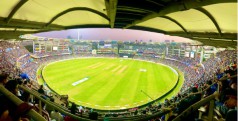



















Sunday, Jul 21, 2024 00:15 [IST]
Last Update: Saturday, Jul 20, 2024 18:47 [IST]
My ode to the mighty Himalayas
Life has always been a platform of surprises for me. Some good, some bad but, mostly great. Filmmaking runs in me. You can call it a passion, or fascination, or whatever. But one thing is clear that storytelling is something that I enjoy the most. Down the years I have managed to gather some wonderful memories and experiences as an assistant director in Hindi cinema in Mumbai.
Having been worked with stalwarts like Baba Azmi, Javed Akhtar, Shabana Azmi, Naseeruddin Shah to name a few and constantly challenging myself to push the boundaries forward. It so happened when I stumble upon this current subject I was completely blown out of my mind. Because the stories of Sonam Wangchuk Lepcha and his achievements along with his teammates is nothing short of an extraordinary Himalayan tale.
One
of the experiences were my days in Dzongu. As I stepped into the lush valleys
of Dzongu, North Sikkim, I was immediately awestruck by the beauty it holds.
This remote region, home to a rich segment of biodiversity, had captured my
heart. My journey to Dzongu was not just a professional endeavour but a
personal quest fuelled by my passion for nature and storytelling. Alongside my
assistant Rahul Barman, I ventured to this exotic landscape to film segments
for our documentary, a project that had already made it to the top 25 of the
Public Service Broadcasting Trust (PSBT) submissions. Being among the top 25
was a big thing, and I felt a deep sense of gratitude for this opportunity.
The support I received from Sonam and
his team at the Thamblyok - Butterfly Society of North Sikkim was delightful. Dilip
Dhakal Sharma, Mingdup Lepcha, Dawa Lepcha, Lakpa Lepcha, Lhendup Lepcha and
Sonam Wangchuk Lepcha Jr. welcomed us with open arms, their dedication and
knowledge about the region enhancing our filming experience. With their
guidance, we captured stunning footage that would form the backbone of our
documentary.
Initially, the weather was kind to us,
allowing for some breathtaking shots. However, by the third day, nature
unleashed its fury. Landslides and flooding began to affect parts of North
Sikkim, and the very bridge that connected us to the rest of Sikkim was
destroyed by the raging river. It was surreal, almost poetic, to be filming a
documentary about climate change and then experiencing its brutal impacts
firsthand.
Despite these challenges, Sonam and
his team took care of us with an incredible level of hospitality. They provided
shelter and comfort in their own home, making sure we were safe and well-fed
despite the lack of electricity, network, or internet. Their will and
resourcefulness were inspiring, and they became more than just collaborators;
they were our lifeline in those critical days.
When the weather finally calmed enough
to allow a narrow path to be cleared, Sonam’s sister, Nima, accompanied us on a
gruelling three-hour trek to reach a point where transportation to Gangtok was
possible. The trek was exhaustive, but the sense of camaraderie and support
from Sonam’s family made it bearable.
Reflecting on this experience, I am deeply
grateful to the Thamblyok Butterfly Society of North Sikkim for their unparallel
support and hospitality. They are the heart and soul of our project, and this
documentary would not have been possible without them. I also extend my
heartfelt thanks to the Public Service Broadcasting Trust (PSBT) for believing
in our proposal and selecting it among the top 25. This recognition is a
testament to the importance of our work and motivates us to push forward,
despite the challenges.
The people of Dzongu left an indelible
mark on us with their warmth. I encourage everyone to visit this incredible
place, not just for its natural beauty but to experience the profound sense of
community and dedication to conservation.
Returning to Gangtok, I couldn't help
but reflect on the journey. We were tired, our bodies aching from the trek, but
our spirits were refreshed. We had captured footage that spoke volumes, but
more importantly, we had formed bonds and collected experiences that would
shape the narrative in profound ways. The team in North Sikkim had become more
than just participants in our documentary; they were now our friends and
collaborators. This journey has solidified my belief in the power of
storytelling and the importance of capturing the beauty of both nature and
humanity. And, last but not the least, I would like to thank my father for the
support that he has given always me.
